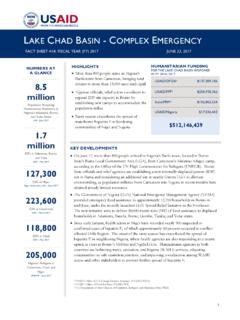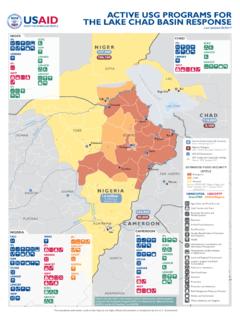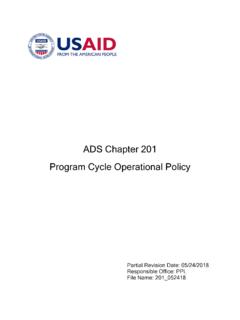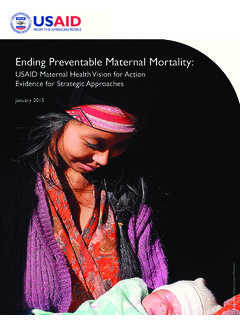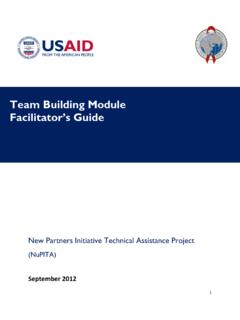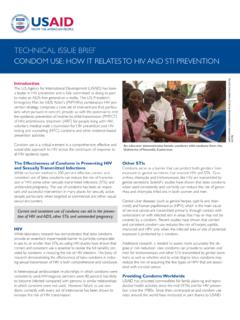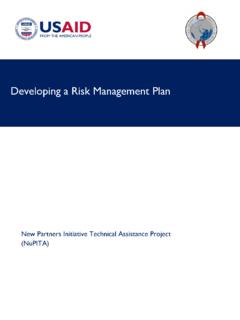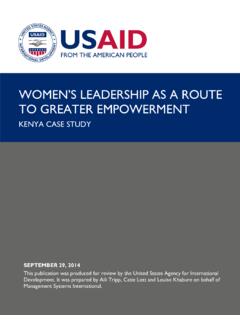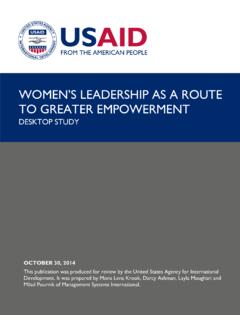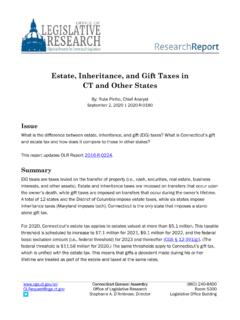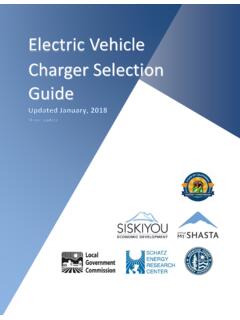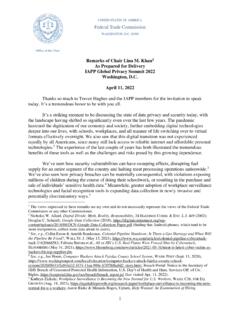Transcription of GENDER AND SOCIAL INCLUSION ANALYSIS: UGANDA
1 August 2017. This publication was produced for review by the United States Agency for International Development. It was prepared by Irene Among ( SOCIAL Development Consultant). DISCLAIMER The author s views expressed in this publication do not necessarily reflect the views of the United States Agency for International Development or the United States Government. GENDER AND SOCIAL INCLUSION ANALYSIS: UGANDAANNE ACKERMANN US EMBASSY PHOTOS ACKNOWLEDGMENTS This paper was commissioned by the Policy and Program Department of USAID/ UGANDA . I thank Erin Wroblewski and Margaret Kasiko, who authored the Terms of Reference, and provided me with good technical guidance through the process. Thanks to Naomi Natukunda for support with the fieldwork, and to the rest of the USAID/ UGANDA Team for providing constructive comments. I thank the technical officials from line Ministries, Kamwenge District, and Sironko District for providing useful insights, especially on the Government of UGANDA s inclusive development policies and programs.
2 I am also immensely grateful to the girls, women, people with disabilities, refugees, LGBTI people, youth, and men who shared their experience of SOCIAL exclusion. Finally, I thank Ameenah Pridgen (CAMRIS International) for contractual and administrative support; and Dr. Arthur Westneat (ZemiTek) for reviewing the report , providing constructive comments, and editorial support. CONTENTS ABBREVIATIONS AND ACRONYMS 1 GLOSSARY OF KEY TERMS 3 EXECUTIVE SUMMARY 5 1. INTRODUCTION 7 CONTEXT 7 THE NATURE OF GENDER INEQUALITY AND SOCIAL EXCLUSION IN UGANDA 8 APPROACH AND METHODOLOGY 11 report STRUCTURE 12 2. GENDER AND SOCIAL EXCLUSION IN THE PROJECT AREAS 13 HOUSEHOLD AND COMMUNITY RESILIENCE PROJECT 13 DEMOGRAPHICS PROJECT 24 HEALTH SYSTEMS PROJECT 36 market SYSTEMS IN KEY VALUE CHAINS PROJECT 42 GOVERNANCE SYSTEMS PROJECT 48 3. THEORY OF CHANGE FOR GENDER AND INCLUSIVE DEVELOPMENT 57 4.
3 FORWARD LOOK: A GENDER AND INCLUSIVE DEVELOPMENT ACTION PLAN 59 PROGRAM DELIVERY APPROACH 59 ACTION PLAN FOR GENDER AND INCLUSIVE DEVELOPMENT 61 IMPLEMENTATION PLAN FOR GENDER AND INCLUSIVE DEVELOPMENT 63 5. CONCLUSIONS AND KEY RECOMMENDATIONS 64 REFERENCES 65 1 | GENDER AND SOCIAL INCLUSION ANALYSIS: UGANDA ABBREVIATIONS AND ACRONYMS ACF Agricultural Credit Facility ADS Automated Directives System ARV Antiretroviral (drugs) CDCS Country Development Cooperation Strategy CDD Community Driven Development CDO Community Development Officer CHEWs Community Health Extension Workers CRRF Comprehensive Refugee Response Framework DFID Department for International Development DO Development Objective DPO Disabled Persons Organization FGM GBV Female Genital Mutilation GENDER Based Violence GGGI Global GENDER Gap Index GII GENDER Inequality Index GoU Government of UGANDA GREAT GENDER Roles, Equality and Transformations IR Intermediate Result LED Local Economic Development LFPR Labor Force Participation Rate LGBTI Lesbian, Gay, Bisexual, Transgender, Intersex MoGLSD Ministry of GENDER , Labor and SOCIAL Development MoESST Ministry of Education, Sports.
4 Science and Technology MMR Maternal Mortality Ratio MoH Ministry of Health M4P Markets for the Poor NDP National Development Plan NPA National Planning Authority OECD The Organization for Economic Co-operation and Development OVC Orphans and Vulnerable Children PAD Project Appraisal Document PFM Public Finance Management PWD Person with disability RMNCAH Reproductive, Maternal, Newborn, Child, and Adolescent Health GENDER AND SOCIAL INCLUSION ANALYSIS: UGANDA | 2 REAL Fathers Responsible, Engaged and Loving Fathers SDSP SOCIAL Development Sector Plan SGBV Sexual and GENDER -Based Violence SIGI SOCIAL Institutions and GENDER Index ToC Theory of Change UCDA UGANDA Coffee Development Authority UDHS UGANDA Demographic and Health Survey UPE Universal Primary Education UWA UGANDA Wildlife Authority VHT Village Health Team VSLA Village Savings and Loans Association WEF World Economic Forum WHO World Health Organization YLP Youth Livelihoods Program 3 | GENDER AND SOCIAL INCLUSION ANALYSIS: UGANDA GLOSSARY OF KEY TERMS Agency: The capacity to make decisions about one s own life and act on them to achieve a desired outcome free of violence, retribution or fear (World Bank 2014).
5 Community: A group of people living in the same defined area sharing the same basic values, organization and interests. Empowerment: Is achieved when women and girls (and other marginalized groups) acquire the power to act freely, exercise their rights, and fulfill their potential as full and equal members of society. While empowerment often comes from within, and individuals empower themselves, cultures, societies, and institutions create conditions that facilitate or undermine the possibilities for empowerment (USAID, 2012). Equity: Equity is defined in terms of two basic principles. The first is equal opportunities: that a person s life achievements should be determined primarily by his or her talents and efforts, rather than by pre-determined circumstances such as race, GENDER , SOCIAL or family background. The second principle is the avoidance of deprivation in outcomes, particularly in health, education, and consumption levels (World Bank 2006).
6 GENDER equality: GENDER equality concerns women and men, and it involves working with men and boys, women and girls to bring about changes in attitudes, behaviors, roles and responsibilities at home, in the workplace, and in the community. Genuine equality means more than parity in numbers or laws on the books; it means expanding freedoms and improving overall quality of life so that equality is achieved without sacrificing gains for males or females (USAID 2012). GENDER : Socially and culturally shaped roles, attributes and expectations assigned to women, men, girls and boys. Household: A person or group of people who normally cook, eat, and live together irrespective of whether they are related or unrelated (UBOS, 2013). Inclusive Development Inclusive Development explores an array of interventions that remove access to development and participation for any number of marginalized groups.
7 Inclusive development means programming that accounts for and addresses the link between development access and SOCIAL identities including, but not limited to, GENDER , disability, ethnicity, and age. SOCIAL Benefits SOCIAL benefits refer to changes to the SOCIAL environment, such as changes in SOCIAL norms or beliefs, economic or legal changes, and to changes in relationships at community and societal levels. SOCIAL capital: Networks together with shared norms, values and understandings that facilitate co-operation within or among groups. It includes: i) Bonds: Links to people based on a sense of common identity ( people like us ) such as family, close friends and people who share our culture or ethnicity; ii) Bridges: Links that stretch beyond a shared sense of identity, for example to distant friends, colleagues and associates; iii) Linkages: Links to people or groups further up or lower down the SOCIAL ladder (OECD, undated).
8 GENDER AND SOCIAL INCLUSION ANALYSIS: UGANDA | 4 SOCIAL Development: A focus on the need to put people first in the development process. It promotes SOCIAL INCLUSION of the poor and vulnerable by empowering people, building resilient societies, and making institutions accountable to the people. SOCIAL exclusion: Process by which individuals or groups of people are systematically denied access to rights, opportunities, and/or services. Based on various axes age, GENDER , sexual orientation, geography, disability, etc. SOCIAL INCLUSION : The process of improving the terms on which individuals and groups take part in society improving the ability, opportunity, and dignity of those disadvantaged on the basis of their identity. SOCIAL norms: SOCIAL norms can be understood as either what most people think and do or, alternatively, what individuals believe most people think and do.
9 As such, SOCIAL norms are about what s considered normal or ought to be normal in a given context and situation. Unpaid care work: Unpaid care work includes all those activities that go towards the well-being of people, including caring for a household such as cooking, cleaning, collecting water and firewood, caring for the ill, elderly and children, and caring for the community when these activities are done for no pay. Note that this does not include unpaid work which is not care such as unpaid labor on family farms or in household enterprises. (USAID, 2016). Youth: USAID uses the term youth and young people interchangeably and while youth development programs often focus on youth in the 15 to 24-year age range, USAID programs also are likely to engage individuals aged 1029 as a broader youth cohort (USAID, 2012). 5 | GENDER AND SOCIAL INCLUSION ANALYSIS: SUMMARY USAID/ UGANDA s Country Development Cooperation Strategy (CDCS) 2016 2021 aims to work towards ensuring that UGANDA s systems are accelerating inclusive education, health and economic outcomes.
10 Six integrated projects are planned, to contribute to the achievement of this goal. They are: i) Resilience Project, ii) Demographic Drivers Project, iii) market Systems Project, iv) Natural ResourcesManagement Systems Project, v) Health Systems Project, and vi) Governance and Citizen Participation Systems Project. The respective projects are elaborated in interrelated Project Appraisal Documents (PADs). For these projects to be effectively implemented, USAID/ UGANDA recognizes that it is important to integrate GENDER equality and INCLUSION of vulnerable groups. USAID therefore commissioned this GENDER and SOCIAL INCLUSION analysis, to identify key GENDER and inclusive development issues and constraints that need to be addressed within its portfolio and to recommend how USAID/ UGANDA can achieve greater inclusive development in its programs.
